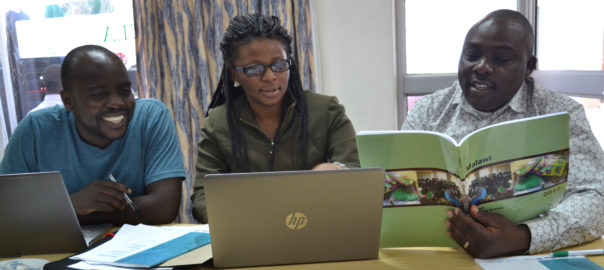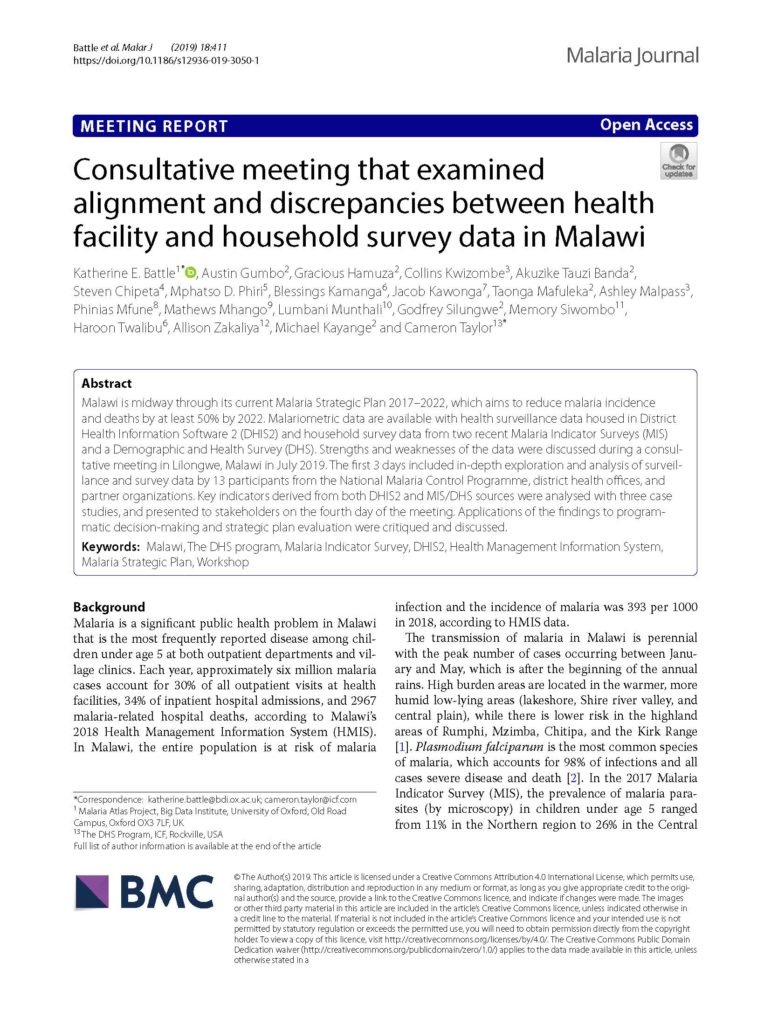Luminare: Insights from a Malaria Consultative Meeting in Malawi

This blog post is part of Luminare, our blog series exploring innovative solutions to data collection, quality assurance, biomarker measurement, data use, and further analysis.
The DHS Program clearly loves data, but what good is collecting data if it is not used, or used only in isolation? This was the motivation behind a Malaria Data Consultative Meeting implemented by The DHS Program and co-facilitated by Dr. Katherine Battle of the Malaria Atlas Project in Malawi in July 2019.
Routine health surveillance data are continuously collected at health facilities in Malawi and entered into District Health Information Software 2 (DHIS2), giving a robust picture of malaria control in Malawi. For instance, each year, approximately six million malaria cases account for 30% of all outpatient visits at health facilities, 34% of inpatient hospital admissions, and 2,967 malaria-related hospital deaths.
The quality and completeness of DHIS2 data vary by facility and only data on people who seek and receive care are included. By contrast, household surveys, such as Demographic and Health Surveys (DHS) and Malaria Indicator Surveys (MIS), are representative of the general population, with comparable data for trend analysis and multi-country comparisons.
At the consultative meeting, malaria data experts developed and presented case studies on indicators that were found in both data sources to check for external consistency and evaluate progress towards Malawi’s Malaria Strategic Plan (MSP) targets. For instance, effective malaria case management is a key component of the 2017–2022 MSP, with targets to test 95% of suspected malaria cases and treat 100% of confirmed cases by 2022.

The DHIS2 data above depicts suspected malaria cases in children under 5 that received a confirmatory test at a health facility. The household survey data above represents children under 5 who had a fever in the previous 2 weeks for whom advice or treatment was sought and who had blood taken from a finger or heel for diagnostic testing. See the table below for more information on these indicators.
| Data source | Available data | Indicator | Numerator | Denominator |
|---|---|---|---|---|
| DHIS2 | 2014–2018 | Percent of suspected malaria cases in children under 5 who received a confirmatory test at facility or village clinic | Number of suspected malaria cases in children under 5 who received a confirmatory test | Total number of suspected cases in children under 5 at facility or village clinic |
| Household survey data | 2014 Malawi MIS and 2017 Malawi MIS | Percent of children under 5 with fever in the previous 2 weeks for whom advice or treatment was sought and who had blood taken from a finger or heel for testing | Number of children under 5 with fever in the previous 2 weeks for whom advice or treatment was sought and who had blood taken from a finger or heel for testing | Total number of children under 5 with fever in the previous 2 weeks for whom advice or treatment was sought |
Adapted from Table 2 in Malaria Journal report.
Both the DHIS2 and MIS data show improvement in confirmatory testing of suspected cases over time, although absolute values differ. Differences were attributed to recall bias among survey respondents. Because the study populations (denominators) of the two datasets are different, it is more meaningful to compare trends rather than absolute values.
As countries move towards malaria elimination it is essential that programs begin monitoring performance using multiple data sources. By using routine surveillance data and household survey data together, malaria data experts have a more complete, unbiased picture of malaria in Malawi.
A report of this Malaria Data Consultative Meeting was published in the Malaria Journal. You can read it here!
Explore Malawi household survey data for yourself using STATcompiler.
Featured image caption: Participants from the Malaria Data Consultative Meeting in Malawi. ©ICF



Good jobs
Hello colleagues, its great article on the topic of teachingand fully explained, keep it up all the
time.